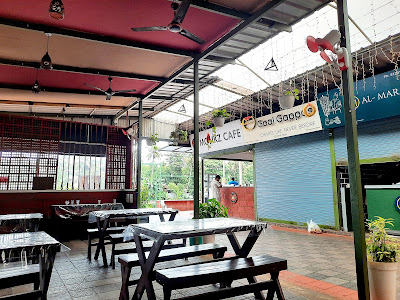A Lonely Food Street in the Rain
“Do you serve momos?” I asked the aging man in Monkz Café,
the only stall that was open at about 11 this morning when I visited The Old
Monk Food Street in my hometown of Thodupuzha. According to the omniscient Google,
this is probably the only place in this town where momos are available.
“What?” the man who managed
everything – brewing tea/coffee, serving snacks, and collecting the cash –
nearly scowled.
I repeated the word ‘momo’ in singular
since Malayalam has an aversion for plurals and the man’s demeanour made me
defensive.
He gave me a smile that was typically
Malayali: mocking as well as naughty. That smile made me wonder whether the word
‘momo’ has some vulgar connotation in Malayalam.
I told him to give me a dal vada and
a coffee, a common order in a Malayali tea shop. As I sat in the elaborate food
court which was empty except for a group of youngsters and one other client, I
observed that all the stalls in the ‘food street’ remained closed. A few
shutters were partly open.
The signboards above those stalls
told me that momos as well as gol-gappas and chaats could indeed be available
in two of the stalls, probably at a later part of the day. One woman stood
cooking at a stall, chopping onions. She said hers would open soon; a few
others, only in the evenings. No one else was visible in any of the others
stalls anyway.
The desolation must owe itself to the
location of the ‘food street’, quite out of the way from the town. The River
View Road is a recent bypass, skirting the town’s chaos and skimming a gentle
river that rolls down beneath the monsoon showers. I guess people come in the
evenings to take a walk by the side of the river though it is not a riverbank
but a manmade, elevated construction that runs along the riverside. It does
make sense to guess that some of the stalls open only in the evenings.
Now, in June-July when the monsoon is
quite heavy in Kerala, it is not likely that people come to walk here at all.
And so, the stalls for momos and gol-gappas may remain closed in the season.
That’s what I gathered from the vague response of the woman who was chopping
onions and who didn’t look particularly happy to answer questions from an old
man who didn’t look like a potential client to her.
Dark clouds were gathering over the
river, which now carried not just the usual outflow from the Idukki dam but
also the heavy burden of monsoon rain. As I walked back to my car in the Old
Monk parking lot, I didn’t fail to notice that the place, particularly the food
court with its wooden tables and benches, has a peculiar romantic charm if it
isn’t crowded. One a warmer day, I will definitely return here with Maggie and
order a plate of momos hopefully from someone who is pleasant. The place does promise
much charm on a sunnier day.
PS. This is the last of
a 5-part series written for #BlogchatterFoodFest
PPS. Notice the additional language on the signboard beside the river asking people not to dump waste in the river. Not Hindi, not English, but Bengali - if I'm not mistaken. My hometown has a lot of migrant labourers from Bengal and possibly Bangladesh too.







Hari OM
ReplyDeleteA bit of a let down, when one was anticipating those juicy little morsels! Dal vada is a trusty substitute though. YAM xx
I understand the place comes alive in the evenings. Not in the monsoon, though.
DeleteMaybe they serve it with Old Monk rum!
ReplyDeleteI'm sure they took the name from that rum. Old Monk was a favourite in Kerala for a long time.
DeleteThanks for the Picturesque pics. And a Confession. Do excuse my lack of touch with New Age Cuisine. What are Momos, in singular or plural and the other rarity, with lots of ggg enmeshed and embedded in it? Thodupuzha does look idyllic, in the Monsoons. Thanks for the photos.
ReplyDeleteMomos are traditional Tibetan dumpling. It was a very common snack item in Shillong. While Shillong used pork-bits as the filling, Delhi used chicken for the same. It isn't easy to find the dish in Kerala.
DeleteTell - tale pics. Articles with local flavour are always interesting to read.
ReplyDeleteI may write more of these since I have a lot of time to move around now.
DeleteI didn’t know that you love momos—such a perfect choice, especially during the monsoon! It’s 2:51 AM and now I’m seriously craving them after reading your blog. You are absolutely right—the instructions are indeed written in Bengali.
ReplyDeleteI'm happy to have whetted your appetite at that unearthly hour.
DeleteThanks for confirming that it's Bengali. You can understand the implications.
Sorry you didn't get your momos. Those proprietors didn't sound like pleasant people.
ReplyDeleteThey're the staff, probably underpaid, and so few patrons
DeleteCrisp and crunchy, a plate of dal vada with chopped onions, fried chillies, and spicy green chutney is the ideal snack for the monsoon. Made from green moong dal and eaten piping hot, these deep-fried dal vadas are truly delicious.
ReplyDelete